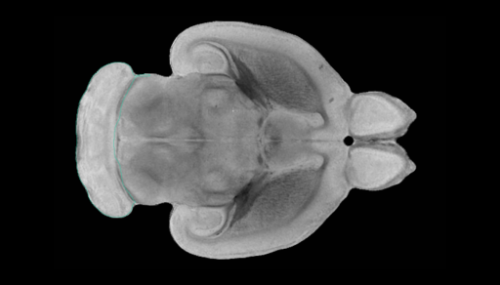Cerebellum of CIVM postnatal rat brain atlas. Credit: Neurolex
Two groups of nerve cells may serve as "on-off switches" for male mating and aggression, suggests a new study in rodents. These neurons appear to send signals between two parts of the brain—the back tip, or posterior, of the amygdala and the hypothalamus—that together regulate emotions including fear, anxiety, and aggression.
Led by researchers at NYU Grossman School of Medicine, the study showed that male mice struggled to have sex in experiments that blocked signals from one amygdala cell group that communicates with the hypothalamus (MPN-signaling cells). When the same signals were instead bolstered, the animals were not only able to mate but would repeatedly court unreceptive females, something they would not do normally.
Similarly, when the action of a second cell group in the amygdala that also communicates with the hypothalamus (VMHvl-signaling cells) was blocked, the rodents attacked unfamiliar males half as often. When these same neurons were triggered, the mice became unusually aggressive, even attacking their female mates and familiar males.
"Our findings provide new insights into the crucial role played by the posterior amygdala in driving male social behaviors like sex and aggression," says lead study author Takashi Yamaguchi, Ph.D., a postdoctoral fellow at NYU Langone Health and its Neuroscience Institute.
Past research suggested the amygdala's role in regulating social behaviors, but until now experts had not uncovered its precise role in sexual behaviors. Instead, researchers had focused on the neighboring hypothalamus, where both the MPN and VMHvl structures are located, as the brain's regulator of mating and fighting.
The new investigation, publishing online July 27 in the journal Nature Neuroscience, is the first to uncover two distinct groups of cells that facilitate communication between the posterior amygdala and the parts of the hypothalamus responsible for sex and aggression, says Yamaguchi. It also provides key evidence that the posterior amygdala exerts "tremendous" influence over social behavior, he adds.
For the study, the researchers observed brain cell activity in more than 100 male mice that were mounting and fighting. The authors measured how often the nerve cells naturally fired signals throughout the animals' day. They found that MPN-signaling cells were most active during sex, while VMHvl-signaling cells were most active during confrontations with other males. For each of the two cell groups, the researchers then suppressed or activated the neurons and observed how often the mice attempted to mount a mate or attack a strange male placed in their enclosure.
"Our new understanding of which cells prompt sexual and aggressive behaviors should help us choose better brain targets as we design future treatments for psychiatric disorders," says senior study investigator Dayu Lin, Ph.D., an associate professor at NYU Langone and its Neuroscience Institute.
Still, Lin cautions that much of the posterior amygdala's structure remains poorly understood and that researchers still need to determine how these findings might translate to human brains. Her team also plans to study how the two groups of nerve cells interact in the brains of female rodents.
More information: Posterior amygdala regulates sexual and aggressive behaviors in male mice, Nature Neuroscience (2020). DOI: 10.1038/s41593-020-0675-x , www.nature.com/articles/s41593-020-0675-x
Journal information: Nature Neuroscience
Provided by NYU Langone Health
























